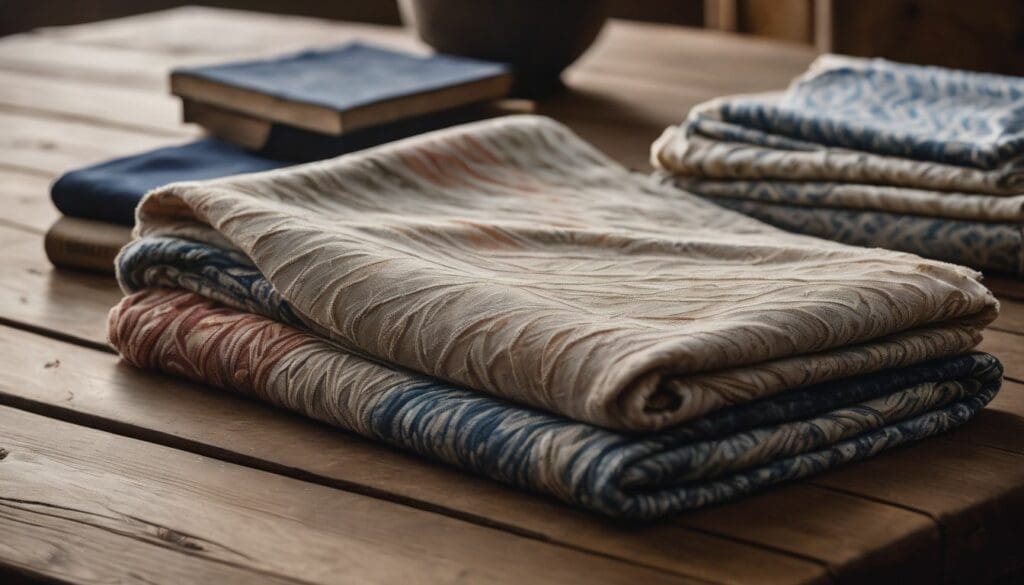As we increasingly become aware of the significant mark our clothing choices make on the environment, it’s imperative that we actively seek out more sustainable options. The journey to a greener wardrobe can sometimes feel like navigating through an intricate labyrinth, but take heart – we’re here with you every step of the way.
Our thorough investigation into eco-conscious textiles is at your disposal. This guide will illuminate the path towards fabrics such as organic cotton and recycled polyester, which not only look good but do good for our precious planet too.
So come along and let’s spruce up your attire with a touch of environmental care!
Key Takeaways
- Sustainable fabrics like organic cotton and recycled polyester help lessen environmental harm by reducing pesticide use, conserving water, and recycling plastic waste.
- Choosing eco – friendly textiles such as hemp, lyocell (Tencel), Pinatex from pineapple leaves, and BananaTex contributes to sustainability through ethical sourcing and reduced resource consumption.
- When selecting sustainable materials for clothing, researching brands’ approaches to eco-friendliness, considering both natural and synthetic options, reading product labels for certifications like GOTS or OEKO-TEX Standard 100 is crucial.
- Alternatives to traditional materials are emerging; Peace Silk offers a cruelty – free silk option while maintaining luxury fabric qualities.
- Staying updated with the latest advancements in sustainable fashion is key to making informed decisions that align with personal values of preserving the environment.
Understanding Sustainable Fabrics
Sustainable fabrics are materials that are environmentally friendly and ethically sourced. It is important to use sustainable fabrics to reduce the overall environmental impact of the fashion industry.
Definition of Sustainable Fabrics
In essence, sustainable fabrics are the heroes in our quest for an eco-friendly wardrobe. They’re materials crafted with care for both people and the planet, ensuring we dress stylishly without harming our environment.
These textiles aim to reduce waste, cut down on water and energy use, and avoid nasty chemicals that can damage Earth’s ecosystems.
We see a wave of these ethical materials sweeping through fashion – from organic cotton free from harsh dyes to recycled polyester born out of plastic waste. By choosing clothes made from these earth-conscious fibres, we’re not just picking out an outfit; we’re casting a vote for the type of world we want to live in.
Importance of Using Sustainable Fabrics
Choosing sustainable fabrics is crucial for reducing the environmental impact of textile production. By opting for eco-friendly textiles such as organic cotton, recycled polyester, hemp, and other natural fibres, we contribute to lessening the carbon footprint and promoting responsible sourcing.
Sustainable fabrics help in minimising textile waste and decreasing reliance on non-renewable resources. Furthermore, they support environmentally friendly fashion initiatives by offering biodegradable options that align with our commitment to a greener planet.
Sustainable fabrics also promote a healthier lifestyle by minimising exposure to harmful chemicals often used in conventional textile manufacturing. Embracing these materials encourages innovation within the fashion industry towards more climate-friendly textiles while boosting awareness about responsible consumption habits that are vital for the sustainability of our planet’s future.
Organic Cotton
Organic cotton is a sustainable option that is grown without the use of harmful chemicals, making it better for the environment, farmers, and consumers. This fabric offers numerous benefits such as reduced water consumption and soil erosion, but it also comes with its own set of production challenges and limitations to consider.
Benefits of Organic Cotton
Organic cotton provides several benefits:
- Requires fewer pesticides and chemicals, reducing environmental impact.
- Supports healthier working conditions for farmers and workers.
- Promotes biodiversity and soil fertility, enhancing sustainability.
- Reduces water consumption during cultivation compared to conventional cotton.
- Offers a natural, biodegradable option for fabric production.
Production Process
Recycled polyester is made from plastic waste, consuming fewer resources than normal polyester. The production process involves the following steps:
- Sorting: Plastic bottles are collected and sorted by type and color.
- Cleaning: The bottles are cleaned to remove any impurities such as labels and caps.
- Shredding: The clean bottles are shredded into small pieces.
- Melting: The shredded pieces are melted down into a liquid form.
- Spinning: The liquid is then extruded through spinnerets to create long filaments of polyester yarn.
- Collection: Post-consumer or post-industrial cotton waste is collected for recycling.
- Sorting: The collected cotton waste is sorted by color and quality.
- Shredding: The sorted cotton waste is shredded into smaller fibers.
- Blending and Spinning: The shredded fibers are blended with virgin organic or conventional cotton fibers and spun into yarn.
Challenges and Limitations
Organic cotton production faces challenges such as lower yields and higher labor costs, making it more expensive than conventional cotton. Additionally, organic farming methods can be more vulnerable to pests and diseases, leading to potential yield losses.
Furthermore, the certification process for organic cotton can be rigorous and costly for small-scale farmers, hindering wider adoption. Recycled polyester presents limitations in terms of microfiber shedding during washing which contributes to plastic pollution in water bodies.
Also, the recycling process may involve chemicals and energy-intensive procedures. These challenges call for continued research and innovation to address sustainability issues while meeting consumer demand for eco-friendly fabrics.
Recycled Polyester
Recycled polyester, also known as rPET, is a sustainable alternative to traditional polyester fabric. It is made from recycled plastic bottles and has the same qualities as virgin polyester but with a lower environmental impact.
This process of recycling reduces the amount of plastic waste in landfills and oceans, making it an eco-friendly choice for textile production.
Advantages of Recycled Polyester
Recycled polyester reduces the demand for new petroleum, thus decreasing our reliance on fossil fuels. It also diverts plastic waste from landfills and oceans, contributing to environmental conservation.
- Recycled polyester is made from post – consumer plastic bottles, reducing the amount of plastic waste in the environment.
- It requires less energy and water to produce compared to virgin polyester, leading to a lower carbon footprint.
- The production of recycled polyester emits fewer greenhouse gases than traditional polyester manufacturing.
- Utilising recycled polyester in fabrics helps to reduce the extraction of crude oil needed for conventional polyester production.
- Recycled polyester supports a circular economy by repurposing existing materials rather than creating new ones from scratch.
- Clothing made from recycled polyester is durable and offers excellent moisture – wicking properties, making it suitable for sportswear and outdoor gear.
- Using recycled polyester in fashion promotes sustainability and aligns with eco-conscious consumer choices.
How rPET is Made
- Collection of PET Bottles: Used PET bottles are collected from recycling centres and consumers to be processed.
- Sorting and Cleaning: The collected bottles are sorted by colour and cleaned to remove any impurities such as labels or caps.
- Shredding: The cleaned bottles are then shredded into small flakes to increase the surface area for processing.
- Melting and Pelletising: The shredded flakes are melted down and formed into small pellets.
- Spinning: These pellets are then extruded through a spinneret to form long filaments that can be woven into fabric.
- Weaving or Knitting: The spun filaments are woven or knitted into fabric, which can then be used in various textile applications like clothing, bags, or upholstery.
Other Sustainable Fabrics to Consider
When it comes to sustainable fabrics, there are several other options worth considering. From the versatile and durable hemp fabric to the innovative and eco-friendly Pinatex made from pineapple leaves, these alternative fabrics offer a range of environmental benefits.
Each material has its unique properties and advantages, making it essential for consumers to educate themselves on the various sustainable fabric options available in the market.
Hemp
Hemp is a highly sustainable and versatile fabric, making it an excellent choice for eco-friendly fashion. It is derived from the hemp plant, which grows quickly without the need for pesticides or herbicides.
Hemp fabric is known for its durability and breathability, making it suitable for various clothing items such as shirts, trousers, and outerwear. Additionally, hemp cultivation requires minimal water and land compared to other crops like cotton, thus reducing environmental impact.
Notably, Hemp fiber can be used in combination with other materials to create blended fabrics that offer unique properties such as moisture-wicking and antibacterial features. This makes hemp a popular choice among environmentally conscious consumers looking for sustainable options in their wardrobe.
Lyocell
Transitioning from discussing the benefits of hemp, we now turn our attention to a sustainable fabric that has been gaining popularity for its eco-friendly properties – Lyocell. Also known as Tencel, Lyocell is a type of rayon fabric made from cellulose fibers found in wood pulp.
This fabric is produced using a closed-loop process, where the solvents and water used are recycled, making it an environmentally friendly choice.
Lyocell boasts impressive attributes; it is biodegradable and requires less water and energy during production compared to other textiles. Additionally, garments made from Lyocell are breathable, moisture-wicking, and offer exceptional comfort.
Pinatex
Pinatex is a sustainable alternative to leather, made from the fibres of pineapple leaves. This eco-friendly material provides a cruelty-free option for creating fashion and accessory items.
As a byproduct of agriculture, Pinatex utilises the remnants of pineapple harvests that would otherwise be discarded, making it an environmentally responsible choice. Its production also supports local farming communities in developing countries where pineapples are grown.
Moreover, Pinatex offers a durable and versatile textile suitable for various applications such as shoes, bags, and clothing. With its unique texture and natural aesthetic appeal, this innovative fabric fits into the growing demand for sustainable fashion alternatives.
BananaTex
Moving on from Pinatex, another innovative sustainable fabric to consider is BananaTex. Derived from banana plants, this eco-friendly textile provides an alternative to traditional materials like cotton and polyester.
With its biodegradable properties and minimal impact on the environment, BananaTex offers a unique and sustainable option for clothing and accessories.
The production process of BananaTex involves utilising banana plant fibres that would otherwise be discarded as waste, making it a renewable resource with low environmental impact.
Peace Silk
Transitioning from sustainable fabrics made from banana plant fibers to another remarkable option, peace silk stands out as a cruelty-free alternative. Also known as ahimsa silk, peace silk is derived without harming the silkworms in the process.
While traditional silk production involves boiling silkworms alive to obtain their cocoon threads, peace silk ensures that the moth can emerge and complete its natural life cycle. This gentle approach aligns with the values of eco-conscious consumers seeking ethically produced textiles.
Peace silk offers an environmentally friendly and compassionate choice for those who value sustainability and animal welfare, making it a standout option in the world of sustainable fabrics.
How to Choose Sustainable Fabrics
When it comes to choosing sustainable fabrics, it’s important to research brands and their commitments to eco-friendly practices. Whether you’re considering natural or synthetic options, always read labels carefully and stay informed about the latest advancements in sustainable textiles.
Research Brands and Their Commitments
When researching sustainable fabrics, it is important to consider the commitments and initiatives of different brands. Look for brands that prioritise transparency in their supply chain, use eco-friendly production methods, and support fair labour practices.
Check for certifications such as Global Organic Textile Standard (GOTS) or OEKO-TEX Standard 100 which ensure that the products are made with environmentally friendly materials and processes.
Consider brands that are actively working towards reducing their environmental impact by using renewable energy sources, implementing waste reduction strategies, and promoting circular economy principles.
Consider Natural and Synthetic options
When choosing sustainable fabrics, it is essential to consider both natural and synthetic options. Natural fabrics like organic cotton, hemp, and lyocell are biodegradable, renewable, and have lower environmental impacts compared to synthetic fibers.
On the other hand, recycled polyester offers a sustainable alternative among synthetic options as it reduces plastic waste by repurposing discarded materials. Understanding the benefits of each option and their impact on the environment can guide you in making informed decisions when selecting eco-friendly textiles for your gaming outfits.
Consider Natural and Synthetic options to ensure compatibility with your environmentally-conscious lifestyle while enjoying comfort and style during your gaming sessions.
Read Labels Carefully
When choosing sustainable fabrics, it’s essential to read labels carefully. Look for certifications such as GOTS (Global Organic Textile Standard) or Oeko-Tex Standard 100 which indicate the fabric has met specific environmental and social criteria.
Additionally, pay attention to the content of the fabric – whether it’s organic cotton, recycled polyester, hemp, lyocell, or any other eco-friendly material. Being aware of what you are purchasing can help you make informed decisions that align with your sustainability goals and contribute positively to a more eco-conscious fashion industry.
Moving on from understanding sustainable fabrics, let’s explore how different brands are making commitments towards sustainability in their production processes.
Stay Informed
To make informed decisions about sustainable fabrics, it is essential to stay updated with the latest information on eco-friendly textiles and materials. Keep an eye out for news and advancements in sustainable fashion, as well as any debates or discussions surrounding the sustainability of different fabrics like cotton and polyester.
Being aware of the ongoing developments in this field can help you navigate through various options available when choosing clothing or textiles that align with your environmental values.
Stay informed by following updates from credible sources, staying up-to-date with industry trends, and seeking out reliable information about sustainable fibers.
Understanding the evolving landscape of sustainable fabrics will empower you to make more conscious choices while considering alternatives to conventional clothing materials. By staying informed about the latest innovations and trends within sustainable fashion, you can broaden your knowledge base and actively contribute towards a more environmentally friendly approach to textile consumption.
Conclusion
In conclusion, sustainable fabrics offer a range of eco-friendly options for clothing materials. Organic cotton and recycled polyester are two popular choices due to their lower environmental impact.
It is essential to stay informed about the various sustainable fabric options available and consider their production processes before making a purchase decision. When choosing sustainable fabrics, it’s important to research brands’ commitments and read labels carefully to ensure you make an environmentally conscious choice.
FAQs
1. What makes a fabric sustainable?
A sustainable fabric is environmentally friendly and made from eco-friendly textiles like organic cotton, recycled polyester, or bamboo fabric. These materials are often biodegradable or recyclable.
2. Why should I choose eco-friendly fabrics?
Eco-friendly fabrics like green textiles and biodegradable fabrics help reduce environmental impact by using fewer resources, cutting down on waste, and avoiding harmful chemicals.
3. Are recycled textiles as good as new ones?
Yes, recycled textiles are high-quality materials that lessen our need for new resources by repurposing existing fibers into climate-friendly textiles.
4. Can clothing be both stylish and environmentally friendly?
Absolutely! Sustainable fabrics offer a variety of options that make organic clothing stylish without harming the planet with renewable and ecofriendly materials.
5. How do I know if a textile is truly sustainable?
Look for certifications or labels stating the textile is made from organic or recycled materials to ensure you’re choosing genuinely sustainable, ecofriendly textiles.





